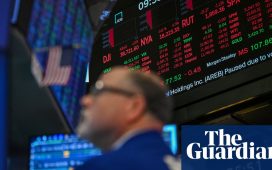Unlock the Editor’s Digest for free
Roula Khalaf, Editor of the FT, selects her favourite stories in this weekly newsletter.
When the Empire State Building was completed, its roof deck was, optimistically, designed as a docking port for blimps. The idea was to moor airships to its mast and facilitate a new era in transatlantic travel, depositing visitors to the New York streets via high-speed elevators. It was a massive failure, the winds were too high and unpredictable and only one airship ever managed to dock.
The owners quickly repurposed the dock as an observation deck and, in its first year of operation, made $800,000 — not that far off the $1mn that the rentals from the offices in the whole tower made that year. It was a masterstroke. It also points to the real role of skyscrapers, which is always about spectacle as much as speculation.
This anecdote is the opener to Cities in the Sky, Jason Barr’s enthusiastic celebration of the skyscraper. Only then the economist goes on to make the opposite case: rather than mere monuments of spectacle, skyscrapers are engines of progress — the future for densifying cities, for increasing housing equity and even for improving the environment. If building mile-high skyscrapers is a real possibility, as he suggests, “a city of 9 million (about the same size as New York, London or Hong Kong) could be housed in a mere three hundred buildings”.
He takes Hong Kong as his exemplar of how high-rises are good for us. The city boasts more skyscrapers in a denser area than any other in the world. Its towers are mostly not super-tall or super-flashy, instead they are an extrusion of land values; with prices for limited space so high, the only way is up. But unlike, say, New York’s new breed of “skinnyscrapers” casting shadows along the southern edge of Central Park, a third of Hong Kong’s high-rises are social housing.

Skyscrapers can mean different things in different places. In mainland China and the Gulf, they represented “arrival” in the world of modernity and affluence. Meanwhile, in cautious London, the presence of the empty Centre Point, a sleek 1960s West End office tower, which for decades looked like a Swinging Sixties property scam, and much-derided local authority high-rises tainted the image of the skyscraper. Only in this century did the taint wear off, opening the way to a sprawl of generic and mostly unnecessary clusters of towers produced largely for investors rather than residents.
Barr chronicles the never-ending race to be the tallest, from its genesis in Chicago to the second wave of globalisation at the end of the 20th century. He begins with developers rather than architects, which is welcome, but the juiciest stories of bankruptcies, corruption and over-reach are largely absent.
Towers conceived to be the tallest are a subset, like people trying to break the record for the world’s biggest pizza. He touches, briefly, on the latest spiky “egoscraper”, the kilometre-high Jeddah Tower in Saudi Arabia, which began construction more than a decade ago but remains a sinister-looking scaffolded stub — a concrete expression of the architecture of pointlessness.
The author is good on origins — on how Chicago kicked off the vogue for highness but lost to New York. Yet that is well-covered territory and there might have been room for the remarkable stories of those who built them: the Mohawks who dominated steel-framed construction with a seeming total lack of fear of heights or the Central Americans who currently make up the crews erecting these gargantuan towers. Or perhaps the unions that retain such an extraordinary grip on power in the US, while in the Gulf towers are only made possible by underpaid immigrant workers.
There is plenty to enjoy here, on everything from structural engineering and elevator technology to spires and the economics of views. But Barr is a booster and there is curiously little questioning of the sustainability of these things. Sure, building densely is commendable, but tall towers preclude natural ventilation and consume vast amounts of concreted energy. It is far more sustainable to build six or seven storeys with opening windows and stairs that people might reasonably climb.
These charismatic megafauna of the architecture world will continue to excite and frustrate. A new skinny supertall, 262 Fifth Avenue, is currently irritating New Yorkers as it blocks views of the Empire State. Yet this is a city with no controls on height. In theory, with enough air rights, you could build upwards forever.
Cities in the Sky: The Quest to Build the World’s Tallest Skyscrapers by Jason M Barr Scribner $32.50/£25, 384 pages
Edwin Heathcote is the FT’s architecture critic
Join our online book group on Facebook at FT Books Café and subscribe to our podcast Life & Art wherever you listen










